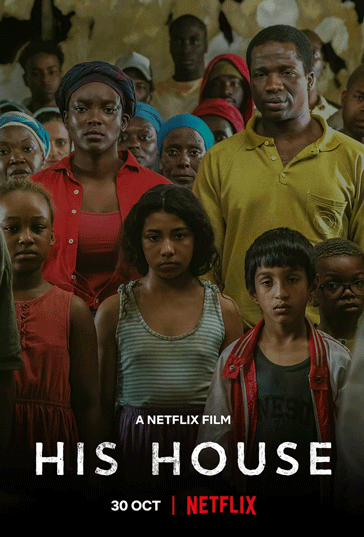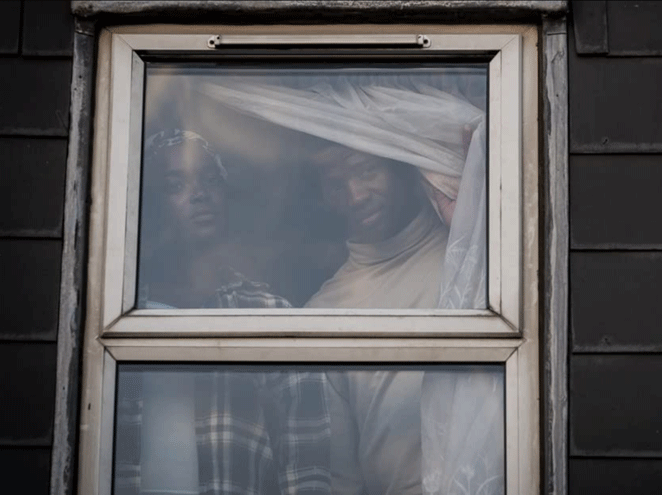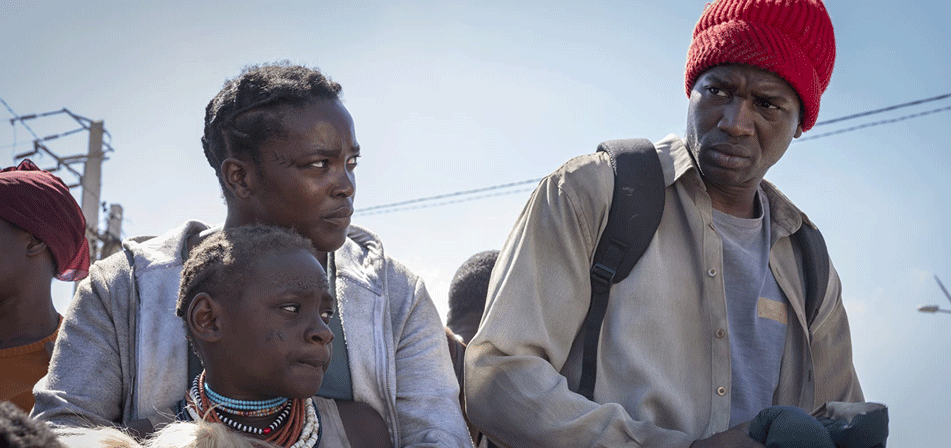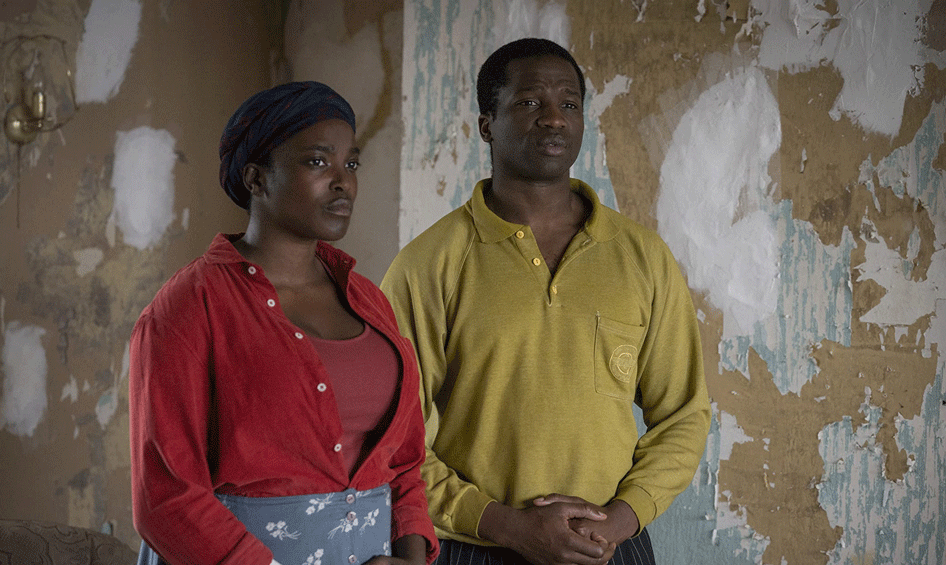Be one of the good ones.
In the midst of the hauntingly beautiful and eerie scenes of the horror movie His House, there is one moment that stands out. A caseworker, Mark Essworth, tasked with helping the refugee couple Bol and Rial Majur settle into their new life in the United Kingdom, delivers the quote above. It is a stark reminder of the uneasy position that refugees occupy in their new homes, caught between the horrors of their past and the apathy or even hostility of their new community. As Bol and Rial struggle to find their place in a world that seems eager to see them gone, this line becomes a haunting refrain, a symbol of the constant pressure to prove themselves worthy of their new home.
His House tells the story of Bol and Rial, a south Sudanese couple played by Sope Dirisu and Wunmi Mosaku, who have been granted asylum in the United Kingdom after fleeing their war-torn homeland. The film, directed by Remi Weekes, has garnered critical acclaim for its ability to blend the horror genre with social commentary, exploring the emotional and psychological trauma that refugees face when forced to leave their homes and start a new life in a foreign land. Weekes has won a BAFTA award for the film in the category Outstanding Debut by a British Writer, Director or Producer. Furthermore, the film has won several British Independent Film Awards in the categories of Best Actress, Best Production Design and Best Director. In tracing the experiences of refugees in the Global North, the film addresses two crucial cornerstones in the United Nations Sustainable Development Goals with the first, being the goal of Reduced Inequalities within and amongst countries and second, to promote Peace, Justice and Strong Institutions for all and especially the marginalized.

The opening scenes of His House thrust us into the perilous journey of Bol and Rial, as they brave the treacherous waters of the English Channel to seek refuge in the United Kingdom. They travel with a young girl, seemingly their daughter. The story then takes us to a detention centre for refugees, where the couple are living by themselves, implying that their daughter did not survive crossing the Channel. The couple is informed that they have been granted a house. However, the relief of finally finding a safe-haven is short-lived as they are given strict conditions that must be followed, or risk being sent back to the dangerous land they left behind. With only 74 pounds per week to live on and unable to work, they must report to authorities regularly. Furthermore, they must live in a home chosen for them, with no possibility of moving. Bol, trying to reassure the authorities of their worthiness utters a heartbreaking plea, “We are good people.”
This stark reality of life as an asylum seeker is a powerful reminder of the constant struggle for survival and acceptance faced by refugees. The harrowing story depicted in the opening scenes of His House serves as a poignant commentary on the plight of refugees and the challenges they face in seeking asylum. The film’s portrayal of the couple’s struggles to adapt to their new home and the rigid conditions imposed upon them highlights the dehumanizing treatment often endured by refugees. The International Organization for Migration, a body that is part of the United Nation, estimates that more than 5000 people have lost their lives in attempts to migrate to and within Europe since 2021. This staggering number of deaths underscores the urgent need for more compassionate and effective policies to address the global refugee crisis. His House is a powerful reminder that behind the numbers are real people with hopes, dreams and families who are simply seeking a better life free from persecution and violence.

Bol attempts to assimilate into his new surroundings and “be one of the good ones” quickly. He goes to the pub, sings football songs and insists on using a fork and knife to eat. Rial’s feelings towards her new home are the opposite. On her way to a doctor’s appointment, she is heckled by a group of black teenagers whom she asks for directions. They tell her to “go back to Africa,” a poignant reminder of the inequalities that ethnic minorities face even among their own. Once at the doctor’s appointment, she explains how the markings on her skin are in fact symbols of warring tribes from her home. She confesses that she carved the enemy symbols on herself as a means of protection. The scene teems with Rial’s anger at having given up everything, including her own identity and her home, to survive. She says, “I left a land of death, for the land of the dead.” According to the United Nation, 1 in 5 people have experienced discrimination in their lifetimes. Rial’s experiences reinforce this statistic and reiterate the drastic need to curb discrimination in our societies.
Eventually, the Majurs begin to see and hear the dead in their new house. The strange encounters are interspersed with episodes of PTSD that both survivors are suffering from, drawing an ever so thin line between the horrors of the real world and the horrors of the fictional. Rial, on realising that her husband is seeing and hearing things too, tells him the story of an apeth. An apeth, or night witch, is a supernatural being from South Sudanese Dinka folklore that is said to psychologically and physically consume its victims until its debts are paid. Rial believes that the apeth is haunting them as a result of the fact that they cheated death, while their daughter died. As the film progresses, audiences are alerted to the fact that Nyagak, who was presumably their daughter, was in fact a child abducted by Bol to ensure a chance at boarding a bus to safe passage. Rial does not object to the abduction, but instead promises Nyagak that she will protect her. The supernatural haunting and the intense guilt of the Majurs coincide with the xenophobia they experience in the outside world, compounding their distress and leaving viewers aching for solace for the beleaguered couple.

The audience’s concern for the couple is doubly amplified when Bol begins to tear down the house in an attempt to quell the voices and apparitions that haunt its walls. When their caseworker Mark visits the house he is shocked at the disrepair he finds it in. On asking what has happened, Rial tells him that they are haunted by a witch. Mark, in a gesture symbolic of the Western nonchalance towards the experiences of marginalized sed refugees, tells them to ‘get it together’ or risk being deported. Eventually, Bol accepts the guilt of what he had done and offers to sacrifice himself to the apex so that Nyagak may be returned to Rial. The climax of the movie ends with Rial choosing to save Bol by slaying the apeth, and accepting her newfound reality in a land that does not want her, but that she is once again, compelled to survive in. Finally, Mark revisits the home to find it repaired. Bol tells him that Rial killed the witch, and that this is their home now. Bol says, “Your ghosts follow you. They never leave. They live with you. It's when I let them in, I could start to face myself.” The film ends with poignant shots of Rial and Bol standing in the house, among the dead that were lost in their homeland and on the journey to the United Kingdom.

The horror of Bol and Rial’s experiences are effectively brought to life by Remi Weekes’ tight direction. The movie incorporates various artistic elements that contribute to its eerie atmosphere and overall impact. The movie’s cinematography, for instance, plays a vital role in creating the film’s eerie and claustrophobic atmosphere. The film’s cinematographer, Jo Willems mainly employs close-ups and tight shots to create a sense of confinement and isolation. The use of low-key lighting and shadowy imagery also adds to the film’s suspenseful tone. The project’s sound design is also noteworthy, and creates a lingering sense of unease throughout the duration of the film. Finally, the performances of the lead actors, Wunmi Mosaku and Sope Dirisu, are nuanced and emotional. Their work brings depth and authenticity to their character’s experiences. Mosaku and Dirisu’s performances make both, the film’s supernatural elements as well as the characters’ experiences of xenophobia, immensely grounded and relatable.
His House is more than just a story of things that go bump in the night. Rather, by taking the familiar horror trope of a family moving into a new house that is haunted and combining it with a poignant critique of the asylum system in the Global North, Weekes’ film succeeds in delivering a powerful message about the psychological and emotional trauma of displacement, loss and survival. The film exposes the fallacy of the ‘good refugee’ narrative, where refugees are expected to conform to a preconceived set of behaviours in order to prove their worthiness of asylum. As we continue to confront the global refugee crisis, films like His House serve as a reminder of the pressing need to provide support and protection to the millions of people who have been forced to flee their homes in search of safety and a new life.
